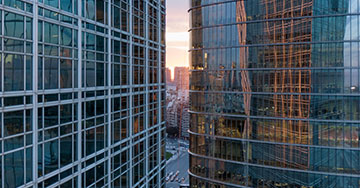
Rethinking energy storage systems
Reducing the reliance on fossil fuels in the Middle East with utility-scale chemical energy storage
In this webcast, Patrik Farkas, Market Development Manager, Middle East, Wärtsilä Energy, talks to three prominent Dubai-based thought leaders about their views on the current status and future projections of the battery storage market in the Middle East. Brendan Cronin, Head of Management Consulting Middle East, AFRY, Sofia Chahbane, Vice President, Business Development, ENGIE, and Giriraj Rathore, Senior Business Development Manager, Wärtsilä Energy discuss the major role utility-scale chemical energy storage looks to play in the Gulf Cooperation Council (GCC) region in the near future.
Driving the deployment of energy storage in the Gulf
All six member countries of the GCC have set ambitious renewable energy and CO2 emission reduction targets as part of the Saudi Vision 2030 programme. “Navigating change in the power sector is never easy, but the wider deployment of energy storage technologies has a real potential to reduce the region’s reliance on fossil fuels and integrate reliable renewable energy sources,” points out Farkas. “Global Li-ion battery prices have witnessed a remarkable decline over the past five years; however, the commercial feasibility of utility-scale energy storage is still facing some headwinds.”
“The main driver for grid-scale energy storage in this region is high renewable integration,” explains Chahbane. “As you can see in recent tenders, the solar PV projects are large compared to other markets, which poses some issues with grid intermittency which energy storage can solve. Secondly, there is a large fleet of combined cycle power plants in the region, and you can integrate utility-scale batteries as boosters to reduce the ramping gradient and of course the associated costs.”
The question of ownership
As the Middle East doesn’t yet have a sophisticated market for ancillary and balancing services, there is an open question as to who should invest in these new assets. “We’ve seen the private sector bring costs down in other technologies in the region, but the catch with storage is the Power Purchase Agreement (PPA) structure needs to be a little more complex – if it’s too simple it reduces flexibility for the system operator,” says Cronin. “With the right PPA structure, it can be private-sector operated on a long-term contract.”
Finding the right placement for energy storage
“Energy storage facilities in the transmission and distribution network can be deployed either close to the electricity consumption, or close to the electricity production site,” explains Rathore. “You should consider the possible revenue streams you can benefit from – the most appropriate location will depend on what you want the battery to do. Of course, there will be some transmission losses that need to be accounted for, but purely from a system integrator perspective, I personally believe the location is not really an issue.”
“As a consultant, I can give you high-level numbers based on the modelling we’ve done,” adds Cronin. “Solar CAPEX today is around $500 per kilowatt of CAPEX, but when we estimate the transmission infrastructure that might be needed, you can almost double that number depending on the country and how far the plants are from the demand centres. The transmission infrastructure can cost you $2–400 per kW – so if you can halve the size of the line you need by smoothing the solar output with a storage project, then that’s a huge saving in terms of transmission build.”
Changes needed to boost deployment further
“If we’re looking at what has to change to encourage energy storage in the Gulf, some sort of a pilot project around standalone storage is right up there on my wish list,” shares Rathore. “It could be very interesting to see what it could do. But generally, I think the deployment of energy storage by individual countries will depend on what kind of value they see it adding to their existing infrastructure, and eventually the cost per unit will be the main driver.
“As well as the price we should also bear in mind that worldwide everyone is going through an energy transition,” adds Chahbane. “Of course, if you want to plan your long-term grid with an energy transition, you need some short-term solutions to maintain stability, and today that solution would be battery storage. It allows system owners and operators to gain some time before they have to plan the next change in investments or the next energy mix.”
A competitive choice for the primary response
“At the moment the most interest in energy storage is coming from primary response applications,” shares Cronin. “Batteries are so well placed for this with relatively cheap capacity, and they respond quickly.”
“That’s true,” agrees Rathore. “But it is also important to remember there are multiple options like cheap gas and flexible engines which are available and still make a lot of commercial sense to asset owners. Energy storage can permanently complement the use of these existing assets – I think the important message is to make use of every possible technology.”
The future of energy storage is just beginning
“We can see that energy storage will certainly have a major role to play in the Middle East,” concludes Farkas. “Currently, the most compelling application is seen in providing primary response to the grid– the deployment of batteries for this purpose is not a question of if, it’s a question of when. Advanced power system modelling can help industry players better understand and determine the role of energy storage in their grids and put an exact price tag on it by stacking revenue streams from different services. Finally, it’s important to emphasise that the specific technical advantages of a battery unit only apply if it’s seamlessly connected to the grid. Therefore, the integration via energy management software will be as important as the hardware itself.”
To find more key takeaways about energy storage in the Middle East, you can watch the webcast in full above.
Presented by

Patrik Farkas
Market Development Manager, Middle East
Wärtsilä Energy Business

Giriraj Rathore
Senior Business Development Manager
Wärtsilä Energy Business

Brendan Cronin
Head of Management Consulting Middle East
AFRY

Sofia Chahbane
Vice President of Business Development
ENGIE
Check out other episodes
Episode 1

Rethinking power grids
How should the Middle Eastern utilities rethink their energy systems to accelerate decarbonisation? Listen to experts from Mott MacDonald and Wärtsilä discuss the main operational and planning challenges to tackle.
Episode 3

Rethinking tomorrow’s generation portfolio
AGL Energy is the largest energy producer in the Australian market. What are their experiences and insights on the journey towards decarbonisation? How have they had to rethink its business model in the changing energy landscape? Listen to experts from AGL and Wärtsilä discuss about tomorrow’s generation portfolio and the transition to renewable energy.